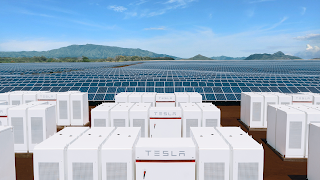Tesla regularly makes headlines in the mainstream media for its surprisingly rare vehicle fires, delays in the base version of the Model 3, and CEO Elon Musk’s Twitter rants, but beyond the headlines, Tesla’s Energy business has been chugging away. As part of that, since 2015, Tesla has installed over 1 gigawatt-hour (GWh) of storage around the world.
Energy storage is crucial for integrating more renewable generation, but is also finding common ground with utilities looking to replace peaker plants. Peaker plants are power plants that are only brought online to support peak energy demand, and because they do not run constantly, they are much less efficient and much more expensive than other electricity generation options.
Increasingly, requests for proposals (RfP) for peaker plant upgrades, replacements, or additions are being fulfilled by grid-scale storage installations. Installations in the tens of megawatt-hours were common last year, with the big splash coming from South Australia, where a massive 129 megawatt-hour battery was installed in just 60 days from contract signing. That’s insane considering that it was the largest battery order in the history of the planet — 30% larger than the 100MWh initially discussed — and also that the batteries are being built at Tesla’s Nevada Gigafactory, conveniently located on the other side of the planet from the project site.
Speaking more broadly about Tesla’s battery installations, Tesla CTO JB Straubel shared that, “It’s at a scale now where it’s undeniably making an impact.”
The South Australia installation is monumental in that it was not only a band aid to cover peak usage but rather, it was purchased to stabilize the grid. A few months in, it is doing just what it promised and then some as it continues to play in the ever-evolving South Australian energy market.
Tesla’s increasing role in grid-scale batteries is being driven by energy markets that are increasingly aware of the potential to save ratepayers money and lower the cost of operation by installing front-loaded batteries that require little to no ongoing maintenance beyond the initial purchase. That’s a stark contrast for an industry born and raised suckling on the tit of big oil for its ever increasing thirst for more power.
As awareness of the potential of grid-scale batteries has risen, prices of lithium-ion batteries have fallen. A Bloomberg New Energy Finance report last year found that lithium-ion battery pricing has fallen nearly 20% consistently for the last 6 years. Tesla isn’t known for sharing its pricing, but CEO Elon Musk loves to tease that Tesla continues to set the low bar on battery costs. That shouldn’t come as a surprise considering that Tesla is the only automaker to build its own cells and packs, in partnership with Panasonic.
Read more at Tesla Energy Hits 1 Gigawatt-Hour Milestone in 2 Years

No comments:
Post a Comment